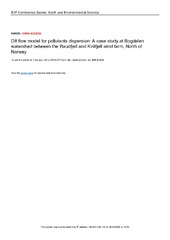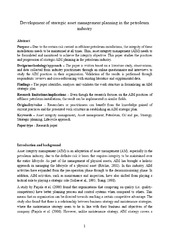Blar i tittel Artikler, rapporter og annet (teknologi og sikkerhet)
Viser treff 60-79 av 309
-
Criteria-Based Fuzzy Logic Risk Analysis of Wind Farms Operation in Cold Climate Regions
(Journal article; Tidsskriftartikkel; Peer reviewed, 2022-02-12)Different risks are associated with the operation and maintenance of wind farms in cold climate regions, mainly due to the harsh weather conditions that wind farms experience in that region such as the (i) increased stoppage rate of wind turbines due to harsh weather conditions, (ii) limited accessibility to wind farms due to snow cover on roads, and (iii) cold stress to workers at wind farms. In ... -
Critical infrastructure resilience: A Nordic model in the making?
(Journal article; Tidsskriftartikkel; Peer reviewed, 2018-08-19)In recent years, there has been a shift in emphasis from critical infrastructure protection to that of resilience. This development reflects the acknowledgment that complete protection can never be guaranteed, and that achieving the desired level of protection is not cost-effective as a rule in relation to the actual threats. This article reviews the responses of four of the five Nordic countries ... -
Cross-Domain Transfer Learning for Natural Scene Classification of Remote-Sensing Imagery
(Journal article; Tidsskriftartikkel; Peer reviewed, 2023-07-05)Natural scene classification, which has potential applications in precision agriculture, environmental monitoring, and disaster management, poses significant challenges due to variations in the spatial resolution, spectral resolution, texture, and size of remotely sensed images of natural scenes on Earth. For such challenging problems, deep-learning-based algorithms have demonstrated amazing ... -
Cyberspace Effects on Civil Society. The Ultimate Game-Changer or Not?
(Journal article; Tidsskriftartikkel; Peer reviewed, 2019-10-04)The article studies the effects of the emergence of cyberspace, or digitization, on civil society, and develops an analytical framework to that effect. It is distinguished between four types of civil societies: apolitical, political, transnational, and uncivic. Each type of civil society is considered separately vis-à-vis cyberspace developments in order to understand what kind of civil society is ... -
D8 flow model for pollutants dispersion: A case study at Bogdalen watershed between the Raudfjell and Kvitfjell wind farm, North of Norway
(Journal article; Tidsskriftartikkel; Peer reviewed, 2019)Investments in wind power are booming in Norway. Several wind power plants have been constructed to exploit the wind energy. However, construction of wind farms has potential impacts on the surrounding environment. Particularly, waste from construction site or activities of workers, leakage of oil and chemical would spread into the nearby waterbodies by runoff or infiltrating into ground. Hence, ... -
Damage Characterisation in Composite Laminates Using Vibro-Acoustic Technique
(Journal article; Tidsskriftartikkel; Peer reviewed, 2021-04-30)The need to characterise in-service damage in composite structures is increasingly becoming important as composites find higher utilisation in wind turbines, aerospace, automotive, marine, among others. This paper investigates the feasibility of simplifying the conventional acousto-ultrasonic technique set-up for quick and economic one-sided in-service inspection of composite structures. Acousto-ultrasonic ... -
Data driven control based on Deep Q-Network algorithm for heading control and path following of a ship in calm water and waves
(Journal article; Tidsskriftartikkel; Peer reviewed, 2022-07-06)A reinforcement learning algorithm based on Deep Q-Networks (DQN) is used for the path following and heading control of a ship in calm water and waves. The rudder action of the ship is selected based on the developed DQN model. The spatial positions, linear velocities, yaw rate, Heading Error (HE) and Cross Track Error (CTE) represent the state-space, and a set of rudder angles represents the action ... -
Data-augmented sequential deep learning for wind power forecasting
(Journal article; Tidsskriftartikkel; Peer reviewed, 2021-11-15)Accurate wind power forecasting plays a critical role in the operation of wind parks and the dispatch of wind energy into the power grid. With excellent automatic pattern recognition and nonlinear mapping ability for big data, deep learning is increasingly employed in wind power forecasting. However, salient realities are that in-situ measured wind data are relatively expensive and inaccessible and ... -
Data-driven modeling of energy-exergy in marine engines by supervised ANNs based on fuel type and injection angle classification
(Journal article; Tidsskriftartikkel; Peer reviewed, 2023-02-16)The application of artificial neural networks with the involvement of a modified homogeneity factor to predict exergetic terms from combustive and/or mixing dynamics in a marine engine is considered in this study. This is a significant step since the mathematical formulation of exergy in combustion is complicated and even unconvincing due to the turbulent and highly nonlinear nature of the combustion ... -
Decentralized System Intelligence in Data Driven Networks for Shipping Industrial Applications: Digital Models to Blockchain Technologies
(Journal article; Tidsskriftartikkel; Peer reviewed, 2019-10-14)Data driven networks applicable for shipping industrial applications to create decentralized system intelligence are considered in this study. Such system intelligence can facilitate to improve the respective operational efficiency in local (i.e. vessel operations) and global (i.e. logistics operations) scales in shipping as the main advantage. The main features of these data driven networks are ... -
Decomposing the Prediction Problem; Autonomous Navigation by neoRL Agents
(Journal article; Tidsskriftartikkel, 2021-07-19)Navigating the world is a fundamental ability for any living entity. Accomplishing the same degree of freedom in technology has proven to be difficult. The brain is the only known mechanism capable of voluntary navigation, making neuroscience our best source of inspiration toward autonomy. Assuming that state representation is key, we explore the difference in how the brain and the machine represent ... -
Deep Learning towards Autonomous Ship Navigation and Possible COLREGs Failures
(Journal article; Tidsskriftartikkel; Peer reviewed, 2019-12-17)A structured technology framework to address navigation considerations, including collision avoidance, of autonomous ships is the focus of this study. That consists of adequate maritime technologies to achieve the required level of navigation integrity in ocean autonomy. Since decision-making facilities in future autonomous vessels can play an important role under ocean autonomy, these technologies ... -
Design and Optimizing the Sea-Spray Collector using CFD
(Conference object; Konferansebidrag, 2022)Sea-spray contributes significantly to marine icing, posing a severe challenge to marine operations in cold regions. There are two parts to spray icing, i) amount of water impingement on marine structure, ii) thermodynamics/heat transfer governing the fraction of spray that freezes and adheres to the structure. Sea-spray collection provides means to investigate into marine icing phenomenon. In this ... -
Design of a Snow Sledge using Multiphysics Analysis
(Conference object; Konferansebidrag, 2014) -
Design, development and deployment of a novel sea spray collector for sea-spray flux measurements
(Journal article; Tidsskriftartikkel; Peer reviewed, 2023-12-19)The risk of sea-spray icing on vessels and marine structures in cold regions highlights the need for an accurate and robust marine-icing estimation model. To develop such a model, it is crucial to accurately determine the quantity of liquid water available for freezing on the structure, as it directly influences ice formation. As sea spray constitutes the primary source of liquid water contributing ... -
Determinants, methods, and solutions of evacuation models for passenger ships: A systematic literature review
(Journal article; Tidsskriftartikkel; Peer reviewed, 2022-09-02)Passenger ships facilitate the mobility of people at sea and are a significant revenue stream for societies. Simultaneously, they should meet safety standards. One of the main safety pillars is offering passengers a reliable emergency evacuation plan. The International Maritime Organization (IMO) has disseminated guidelines for passenger ships to enhance the evacuation process understanding. Although ... -
Determination of Thermal Properties of Fresh Water and Sea Water Ice using Multiphysics Analysis
(Journal article; Tidsskriftartikkel; Peer reviewed, 2016-08-29)This paper presents a methodology to determine the thermal conductivity of ice using multiphysics analysis. This methodology used a combination of both experimentation and numerical simulation. In the experimental work, an ice block is observed using an infrared camera. The results reveal the variation in temperature over the surface. These results are dependent on two primary heat transfer parameters, ... -
Development and Validation of a Safety Leadership Self-Efficacy Scale (SLSES) in Maritime Context
(Journal article; Tidsskriftartikkel; Peer reviewed, 2020-10-21)Extensive studies have highlighted the importance of leadership on safety in the maritime industry. However, current research lacks empirically tested theoretical models with valid and reliable scales for describing and measuring safety leadership in ship operations. This study reports the development and validation process of the first Safety Leadership Self-Efficacy Scale (SLSES) for assessing ... -
Development of strategic asset management planning in the petroleum industry
(Tidsskriftsartikkel; Journal article; Tidsskriftartikkel; Peer reviewed, 2017)<i>Purpose</i> – Due to the certain risk carried in offshore petroleum installations, the integrity of these installations needs to be maintained at all times. Thus, asset integrity management (AIM) needs to be formulated and monitored to achieve the integrity objective. The purpose of this paper is to study the practices and progression of strategic AIM planning in the petroleum industry. ... -
A discipline without a name? Contrasting three fields dealing with hazards and disaster
(Journal article; Tidsskriftartikkel; Peer reviewed, 2022-12-29)A growing number of research fields have been striving for recognition as an academic discipline. Rather than argue that ‘our field’ should also be recognised as such, we stop to ask two fundamental questions. Our first question concerns whether and how disciplinary concerns would benefit research fields dealing with hazards and disasters. Second, we reflect on the implications of not having a broadly ...


 English
English norsk
norsk


















